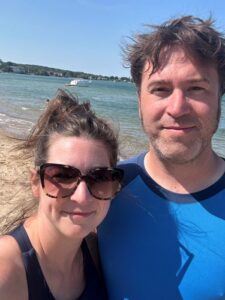Duane Moore's Journey to Diagnosis
 What started as seemingly minor bleeding gums, dismissed as “strawberry gingivitis,” rapidly escalated into a life-altering diagnosis for Duane shortly after his 38th birthday in 2021. This initial symptom was the first clue in a complex journey that led to him being diagnosed with granulomatosis with polyangiitis (GPA), a rare form of vasculitis.
What started as seemingly minor bleeding gums, dismissed as “strawberry gingivitis,” rapidly escalated into a life-altering diagnosis for Duane shortly after his 38th birthday in 2021. This initial symptom was the first clue in a complex journey that led to him being diagnosed with granulomatosis with polyangiitis (GPA), a rare form of vasculitis.
Duane’s dentist, recognizing something more serious than typical gum disease, referred him to a periodontist. There, the possibility of an autoimmune condition was first raised, and blood tests were ordered. The results revealed a positive PR3, a marker often associated with GPA.
As doctors worked to confirm the diagnosis, Duane’s symptoms intensified. “About a month after the initial lab tests, my nose started running. I had extreme pain around my left eye/sinus/temple region, my left upper eyelid became very swollen, and my ears were stuffy,” he recalled. An ophthalmologist visit and an MRI confirmed the presence of an inflammatory mass behind his left eye, along with other concerning findings. The diagnosis of GPA was finally confirmed after a period of escalating symptoms.
“I was on high-dose prednisone from the development of the eye symptoms until starting rituximab infusions a little over two months later,” Duane explained. The prednisone led to a 30-pound weight gain over two months. Tapering off took about a year, but Duane has had no issues with his rituximab infusions, which he receives every six months. He is currently in remission with minimal symptoms and no renal or lung involvement.
Navigating the medical system was a significant challenge for Duane, who had virtually no prior adverse medical history and had never heard of vasculitis. “The journey from initial symptoms through diagnosis and treatment into remission was certainly terrifying and challenging,” he said, noting the difficulty in securing appointments with the right specialists and obtaining appropriate treatments. He took significant time off work for appointments and when he wasn’t feeling well. “It was about two years after starting the rituximab infusions before I truly started to feel mostly normal again,” he added.
“Just quietly do the next and most necessary thing. This is all that any of us can ever aspire to do in any moment and is thus all that you ever have to do.” — From “Four Thousand Weeks,” Oliver Burkeman
This quote by Oliver Burkeman became a guiding principle for Duane. It helped him cope with the overwhelming uncertainty and the sheer number of appointments and treatments, reminding him to focus on manageable, immediate steps rather than getting lost in “what ifs” or long-term prognoses.
“Two big things I learned were that it won’t stay as terrifying as it is initially and that you really do have to advocate for yourself within the medical system,” Duane emphasized. He advises others to “keep a detailed log of your symptoms and all your medical appointments/results and educate yourself on your disease and the treatments” to be an effective advocate.
In an unexpected turn, routine lab work for his rituximab infusions revealed extremely high ferritin (stored iron) levels and elevated ALT liver enzymes. A genetic test confirmed he also has hereditary hemochromatosis. “The high iron levels could have started damaging my heart and liver without me even knowing had we not found that,” Duane noted. This discovery led to therapeutic phlebotomies, initially every two weeks and now quarterly, to manage his iron levels. “In a way, the vasculitis was a bit of a blessing in disguise,” he reflected.
Duane, now 41, is an aerospace engineer and private pilot. He lives in Wichita, Kansas, with his wife of 19 years, Kaley, their three children, and their Golden Doodle, Pepper. His story is one of confronting the unknown, advocating for himself, ultimately finding remission, and a renewed appreciation for life.
